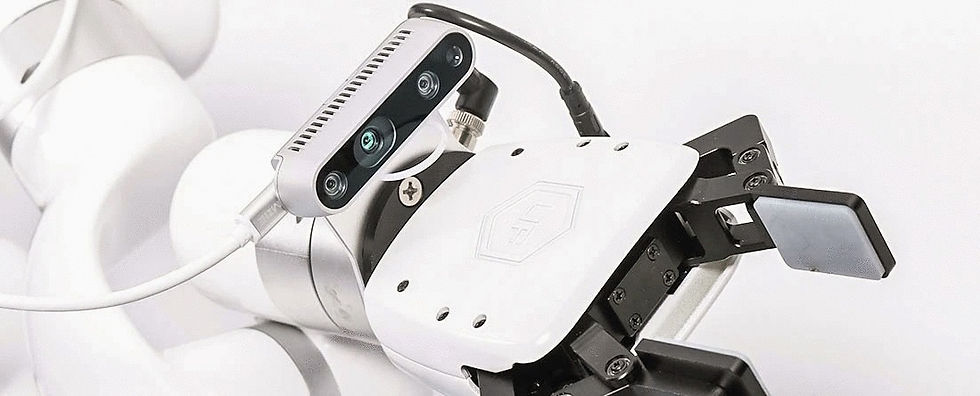Using Robotics for Warehouse Kitting Service and Fulfillment
- Blue Sky Robotics

- Oct 1
- 3 min read
Kitting is one of the most overlooked yet essential parts of the supply chain. In a fast-paced world of e-commerce and just-in-time manufacturing, companies need reliable warehouse kitting service and fulfillment strategies to meet customer expectations. It is apart of a labor-intensive process — gathering multiple parts or SKUs, organizing them into kits, and preparing them for shipping. Today, robotics is reshaping this space, offering greater efficiency, accuracy, and scalability.
Challenges in Traditional Kitting and Fulfillment
Many warehouses still rely on manual labor for kitting. This creates several challenges:
Labor shortages and costs: Hiring and retaining staff for repetitive work is difficult and expensive.
Error rates: Human error in warehouse picking and packing can lead to costly returns and customer dissatisfaction.
Bottlenecks: As order volume increases, manual systems struggle to keep up with demand.
These issues make it clear why automation — specifically robotics — is becoming central to modern fulfillment.
The Role of Robotics in Warehouse Kitting
Robots are uniquely suited to the repetitive, accuracy-focused tasks required in kitting. Warehouse picking robots can handle everything from grabbing small components to preparing bundles for shipment. By integrating with warehouse picking and packing workflows, robotics enables:
Consistent accuracy and fewer errors
Faster order cycle times
Around-the-clock operations without fatigue
Instead of replacing humans entirely, robots free workers to focus on supervision, quality control, and higher-value tasks.
Robot Models Driving Kitting Efficiency
When evaluating robots for warehouse kitting, a few design principles stand out: precision for handling small components, flexibility for adapting to changing SKUs, and safety features that allow robots to operate in diverse environments. Modern collaborative robots (cobots) are designed with these needs in mind, offering simple programming interfaces and scalable performance that fits warehouses of different sizes.
For example, the UFactory xArm series demonstrates how cobots can combine precision and ease of use. The xArm 6 in particular balances payload capacity and reach, making it suitable for repetitive kitting and small-part picking, while remaining versatile enough to shift between different warehouse tasks.
Similarly, Fairino robots highlight the importance of adaptability in dynamic environments. Their lineup includes models with explosion-proof and industrial-grade certifications, allowing automation in specialized or hazardous settings where safety is critical. Because the product family scales easily, Fairino provides a clear case of how robotics can support both small-scale warehouses and larger fulfillment centers.
Advantages of Robotic Kitting Systems
Companies adopting robotic systems for kitting and fulfillment report measurable benefits:
Reduced errors: Robotics lowers mistake rates in picking and packing.
Faster throughput: Orders are processed more quickly, improving customer satisfaction.
Adaptability: Robots handle variable SKUs, supporting industries from e-commerce to manufacturing.
ROI: Lower labor costs and higher output deliver long-term savings.
Use Cases in Real-World Fulfillment
Robotics in warehouse kitting service and fulfillment is already transforming industries:
E-commerce: Subscription boxes, product bundles, and gift sets assembled with speed and consistency.
Manufacturing: Kits of automotive parts or electronic components prepared with precision.
Small-to-medium businesses: Leveraging cobots like the UFactory xArm 6 or Fairino robots to compete with enterprise-level fulfillment centers.
Implementation Considerations
Getting started with robotic kitting doesn’t have to be overwhelming. Businesses can begin with small pilot projects — one cobot-capable robot dedicated to a single task. From there, automation can be scaled to more processes. Key considerations include:
Integration with existing WMS/ERP systems
Training staff to manage and maintain robots
Incremental scaling to match demand growth
The Future of Warehouse Kitting and Fulfillment
The future of kitting is being shaped by several major trends:
Growth of cobot-capable that safely work alongside people.
AI-driven optimization for warehouse picking robots, predicting demand and streamlining workflows.
Hybrid human-robot teams for flexible and resilient fulfillment operations.
No-code robotics platforms that allow operators to adapt robots to new kitting or packing tasks without specialized programming.
Together, these innovations will make robotics more accessible and adaptable across industries.
Conclusion
Warehouse kitting service and fulfillment is no longer a manual bottleneck. Robotics is transforming this critical process into a scalable, precise, and cost-efficient system. Solutions like the UFactory xArms and Fairino robots are helping businesses of all sizes stay competitive in today’s fulfillment landscape.
For companies looking to improve efficiency, reduce errors, and prepare for growth, exploring robotic kitting solutions is no longer optional — it’s the future.



